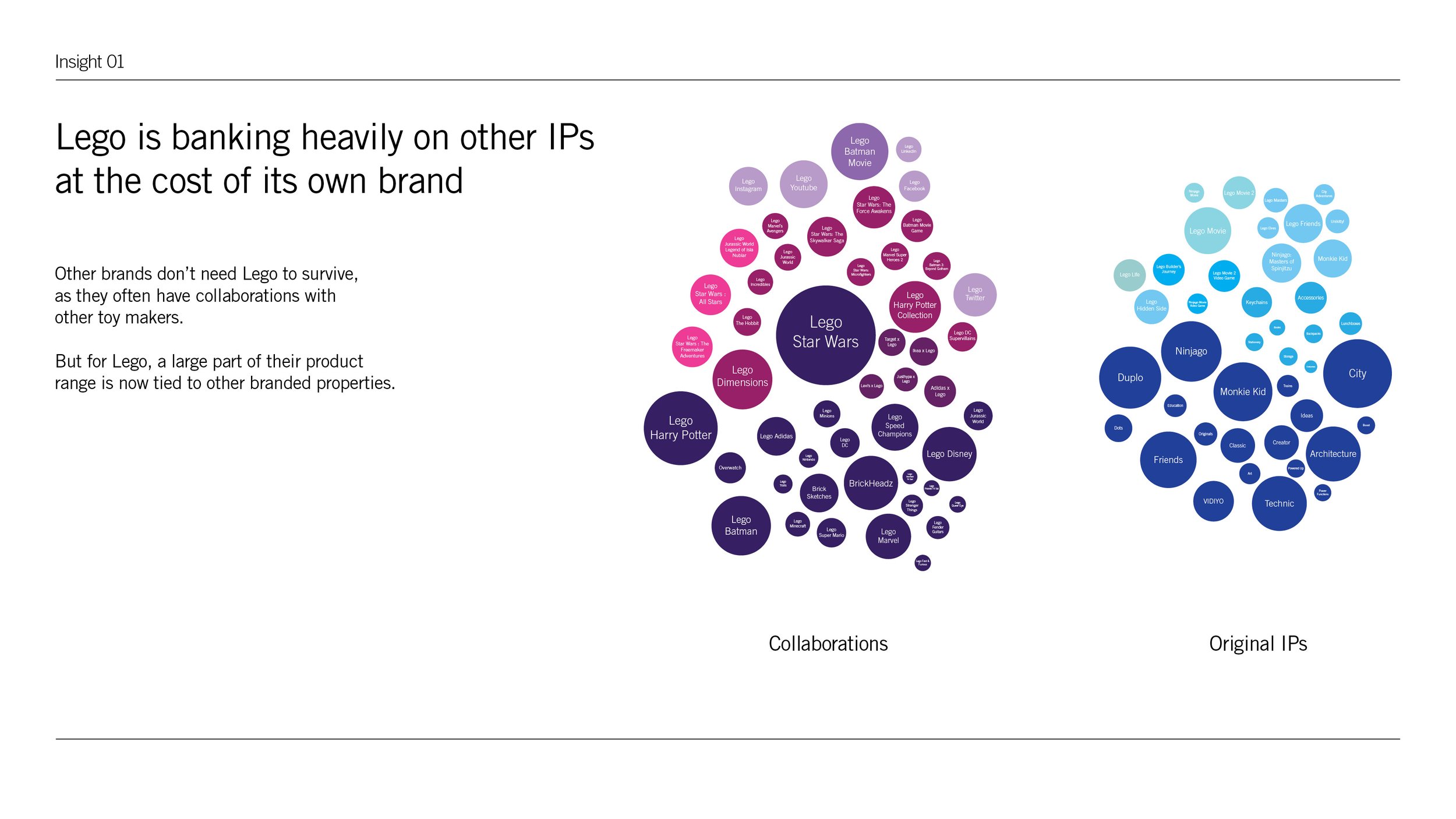Lego
Re-thinking Lego’s ecosystem to suit changing notions of “play”
Design Research
2021
The
Brief
As part of the Experience Modelling class taught by Mark Micheli at the Institute of Design, Palak Shah and I studied Lego’s brand ecosystem in order to understand which areas are undeserved by Lego. Working from previous user research from Kelton, we mapped the Lego ecosystem, studied different customer personas and mental models, and redefined the ecosystem and brand architecture based on the needs of individual mental models, and insights from our research.
Research & Insights
In order to understand the current Lego ecosystem, we first needed to break down what Lego currently does. This research included a review of previous user research (from Kelton); Primary Research, including Store Visits, Site Observations, and Employee Interviews, and secondary research, including a deep dive into Lego’s current and past product line-ups, digital offerings, social media strategy and brand strategy.
This initial research led us to 5 initial insights about the Lego brand:
Lego is banking heavily on other IPs at the cost if its own brand
Fragmented Branding across the Lego Ecosystem.
Lego’s digital offerings are constantly revamped and lack clarity.
Limited differentiation in product packaging.
Lego’s messaging is at odds with their product line-up
Mental Models
We found that “Play” is an integral part of the Lego Brand.
So we studied what “Play” means to different people.
We found 6 different ways in which people play, studied their triggers and buying patterns, looked at how they interact with the Lego Ecosystem and mapped their customer journeys.
Explorer
The Explorer is looking for new, interesting and engaging experiences. They are open to new media and new forms of entertainment.
Shop to find meaning
Gifts from relatives. Introduced to new toys, and want to explore new and different way of manipulating and playing with objects.
Superfan
Fans of other IP’s that want a Lego set as it represents a way for them to physically interact with and engage with the things they love.
They loved the books or movies, have all the merchandise and want more engagement.
Shop to immerse
Extend engagement after a big event. Maybe a new movie, book release, or a big season finale.
Tribe
For slightly older children (and quite a few adults), games with rules are the primary mode of play.
While rules and goals are introduced, they are flexible, and Lego becomes more of a social activity than just a personal toy.
Shop to create interactions
New sets to add variety to their collection for the next big meeting. Wants every group meeting to be creating and exciting for everyone.
Creator
They’ve played with Lego from the time they were young, and enjoy the process of building more intricate sets, or creating something entirely new and unique
They enjoy re-using sets, creating the larger multi-set projects, and are looking for a challenge.
Shop to build
Feel their current toolkit is limiting their expression. They want something more to be able to express themselves in new and interesting ways.
Collector
People that wear their hearts on their sleeve and want to display their passions and hobbies. They have a past relationship with Lego, but also a strong bond with non- Lego IPs from their childhood.
They want to build something large and impressive, but are also looking for something unique and exclusive.
Shop to associate
Feel like there’s a hole in their (literal and metaphorical) display cabinet. There’s a part of their personality that isn’t being displayed.
Nostalgic
They’re looking to buy items they loved to play with (or couldn’t afford) as a child.
They want to relive or reminisce a portion of youth, and the brands they associated with in the past.
Shop to reminisce
Feel like they’ve lost something as they’ve grown up, and want to associate or reminisce with a different point in their life.
“Play” is at the heart of Lego, and drives the current ecosystem.
But “Play” means different things to different people.
Building the ecosystem around “Play” as defined by only one mental model, will lead to disappointment for others
Lego needs to tailor parts of their ecosystem to appeal to these different mental models. Or build separate eco-systems that are focused around the needs to these mental models. These new ecosystems would differ not only in their branding and product lines, but also in their packaging, messaging, retail and digital channels.
The New Brand Architecture
The new Ecosystem Model divides the Lego brand into 3 distinct entities, each with their own distinct sub-brands, packaging, marketing and digital offerings, catering to specific mental models.
The Lego we all know and love. Explore, build and create from the classic block based universe. Follow the instructions. Or throw them away!
Lego
Sub-Brands
The Duplo sets for younger kids.
New
Retained
Duplo
Dinosaurs
The classic Lego themes and lines live here. City, Architecture and more.
Architecture
Originals
Trains
Art
City
Retained
New
Refresh
The Classic brand is now part of Lego stories; refers to Lego made from public domain stories
Reframed
Mythology and classic literature is brought to life through Lego stories, along with current lines such as Monkie Kid and Ninjago.
Monkie Kid
Ninjago
VIDIYO
Friends
Retained
New
Myths
Classic
Castle is now part of the Lego Myths collection
Reframed
Packaging
The Classic Lego cardboard boxes. But these now emphasize the bricks and the building experience, with only a smaller graphic showing the final product.
Marketing and Retail
Lego needs to move out of the world of “toy-stores” and into the real world. Introducing Lego into unexpected places will get people to think about Lego in different ways, and will give Lego reach and visibility away from Lego Stores and Lego Land.
Fewer ads and posters, and more physical installations.
Digital
Lego VIP becomes a hypebeast type platform with different membership levels, and offers members discounts, offers and rare and exclusive sets. This could include times-drops, artist collaborations and other limited edition content.
A “Bricksearch” type function allows them to browse and identify not just current sets, but vintage ones as well.
The VIP app also becomes a trading platform for collectors. Vintage and rare sets can be re-sold through the app, with Lego ensuring the sets are original, have the right packaging and replacing missing pieces.
Lego Storyteller is a new take on the toys-to-life format. This acts as a companion to all the sets under the Stories Sub-brand.
New stories and chapters are unlocked on the completion of sets. An “X-ray”style function allows customers to delve deeper into the story and read about characters, settings, the author etc.
Lego is one of the few “universes” where Hagrid can live alongside Iron-man, Batman and a T-rex. This concept is showcased through a new focus on Brickfilms and user generated Lego content. By focusing on imagining stories and developing them using Lego, the Brickfilms brand appeals to customers that want to engage in pretend play.
Brickfilms
Sub-Brands
An app, a set of toys, and a way to create and share stories, Brickfilms is life (real or imagined) told through the lens of Lego.
Star Wars
Marvel
DC
Harry Potter
Jurassic World
Retained
New
Brickfilms Sets
The concept behind Modular Buildings is now applied to all the big franchise sets. This allows fans to buy a few pieces at a time, or build out a large connected scenes from their favourite movies.
Reframed
Life-size props, objects and costumes, made with Lego. Perfect for your next cosplay.
Lego x Ikea
Lego x Target
Lego x Adidas
Lego x JustHype
Lego x Levi’s
Retained
New
Props
Xtras is expanded to integrate better with the Brickfilms App and sets
Reframed
A new way to collect, share and display characters from film, TV and video games.
BrickHeadz
Retained
The classic Lego mini-figures.
Retained
Minifigures
Packaging
A new kind of display case. The cardboard box comes with a window and an insert showing the final product. When built, the insert can be removed, and the product can be put back on display.
Marketing and Retail
While Brickfilms products would continue to be sold through Lego, the goal is to bring Superfans into the Lego-verse from other brands’ retail platforms.
This would include Brickfilms sets being sold through vending machines, expanding their retail channels outside of toy stores.
Digital
The Brickfilms App allows superfans to make their own brickfilms, share them online and view other brickfilms and Lego-related fan content.
The Brickfilm set(s) include parts to help make these. This could be a functional (but Lego based) tripod, lights, etc.
Xtras grows into a larger theme to provide accessories for making Brickfilms. This becomes similar to the miniature trees loved by train set enthusiasts (and architects), but in a distinctly Lego way.
Technic
Sets that go beyond the basic brick. These are aimed at creators and innovators.
Sub-Brands
Technic adds a layer of functionality that traditional Lego Blocks lack. The Technic brand is more about tools than toys. These are functional pieces that can be used to create functional objects.
Technic
Retained
New
Protoyping Tools
Reframed
Education and Serious Play are now under the Technic brand
Speed Champions expands to include fictional designs.
Ideas is now included in Technic.
Beyond just bricks and block, Technic+ is a connected learning and creation platform.
Retained
New
Nasa X Lego
Reframed
Careers
Mindstorms, Power functions, Powered-Up and Boost are integrated into the Technic+ Brand
Packaging
Packaging inspired by a toolbox. This allows users to collect, carry, store and sort their blocks easily, while also presenting the sets as tools rather than toys.
Marketing and Retail
Technic isn’t a toy, its a set of tools. The blocks aren’t being used to play games, but being used to teach concepts in a physical interactive way.
The Lego Careers sets start to introduce people to various career paths, and teach them the basic concepts of those careers.
While Technics would continue to be sold through Lego’s retail channels, these sets would also be sold in hobby shops, tool stores and art supply stores.
Digital
Digital Designer gets a complete re-vamp to once again serve as a prototyping platform for creators. Lego Ideas is again integrated into Digital Designer, with creators having the option to sell right in the app.
Technic Cam is a new app that allows creators to take photos of real world objects and quickly transform them into functional Lego sets. This app also functions to scan Lego sets and show what new things could be made.
Roadmap
To make the transition to the new brand architecture successful, we also created a roadmap, detailing how Lego could slowly introduce new touchpoints, spin-off the brands, and create unique retail and digital experiences for each brand.



































